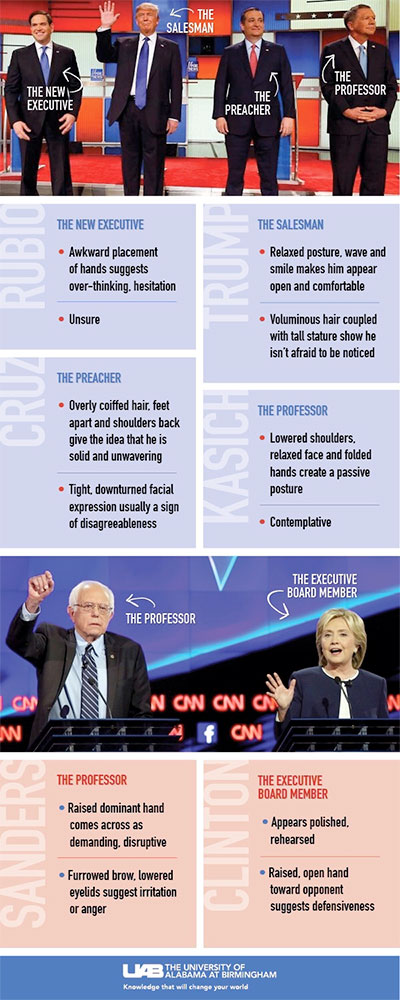Written by: Tiffany Westry
Need more info? Contact us
 Presidential debates are primarily about what the candidates say, but much can be said without even speaking a word. Body language is a critical part of how candidates are perceived by voters. Some candidates invest hours in honing their skills to improve how they come across to the millions of people watching on television.
Presidential debates are primarily about what the candidates say, but much can be said without even speaking a word. Body language is a critical part of how candidates are perceived by voters. Some candidates invest hours in honing their skills to improve how they come across to the millions of people watching on television.
Mark Hickson, Ph.D., professor of communication studies at the University of Alabama at Birmingham, is an expert in nonverbal communication. Ahead of tonight’s Univision Democratic primary debate and Thursday’s CNN Republican debate, Hickson provides an analysis of each candidate’s nonverbal behaviors during the Republican debate held March 3 and the Democratic debate March 6.
Marco Rubio
Hickson describes Rubio as “the new guy” who has just been promoted to an executive-level position. His facial expressions seem uneasy. “He appears afraid to say too much out of fear of being fired,” Hickson said. When faced with criticism from moderators or opponents, Rubio looks away and down at the podium frequently. Breaking eye contact can be a sign of discomfort, guilt or feeling threatened. When responding to certain questions from moderators, he blinks his eyes excessively. This is also a sign of being uncomfortable or feeling stressed.
Many political commentators have said Rubio seems overcoached, and Hickson agrees.
Donald Trump
“Trump shows a lot of dynamism in his gestures,” Hickson said. “In part, that could be because of his level of comfort. If you take an average person and put them on a stage with audience members who are agreeing and nodding their heads, that person is likely to become more relaxed in their movements. He seems to be enjoying himself.” His voluminous hair, coupled with his tall stature, shows he isn’t afraid to be noticed.
Hickson says, since the start of the presidential debates, Trump and Hillary Clinton appear to be the most comfortable of all of the candidates. While Trump does appear comfortable, he has many noticeable nonverbal behaviors. When his opponents say something he does not like, he purses his lips similar to the way a parent might while making eye contact with a misbehaving child. Trump faces his opponents with his torso, not just his head, which could be a sign that he is not intimidated by them. He uses large gestures toward the audience when speaking. “The larger the gesture, the more you bring a person into what you’re saying. It becomes personal,” Hickson said. He added that Trump is unrefined in his behaviors, which contradicts conventional wisdom and thought regarding how someone who is running for president should act in public.
Ted Cruz
According to Hickson, Cruz rarely smiles. While Rubio and Trump smile often, not every smile is a good one, he says. Smiles can be genuine; they can also be defensive or a sign of subtle contempt. If a person bites their lip, this is a sign that they are holding back.
Cruz’s facial expressions are incongruent with his gestures. When his gestures are large and his voice is raised, his face remains unexpressive and often downturned. “Cruz’s speaking style is similar to that of a preacher,” Hickson said. “His gestures and phrasing make him sound as though he is in church.” He adds that his hair is “perfectly coiffed” and doesn’t give him an error factor, which could make him appear less authentic to some. Cruz’s stance when away from the podium gives the idea that he is solid or unwavering. The placement of his legs is wide. His feet are firmly planted, and his shoulders are pushed back as if bracing for impact.
John Kasich
“Kasich isn’t dynamic,” Hickson said. His posture is relaxed. His tone and gestures are similar to those of a professor giving a lecture. Kasich is always passive in his posture, Hickson says. When standing behind the podium, he holds his hands behind his back or often folds them when speaking. His shoulders are lowered, and his gestures are kept contained compared to those of other candidates.
Bernie Sanders
Sanders uses a lot of right-hand gestures. “Most of the time, his nonverbal behavior comes across more like a discussion than a lecture,” Hickson said. However, when challenged or interrupted by his opponent, his behavior becomes defensive. This can be seen through his high gestures, pointed finger and raised voice. You may also notice his furrowed brow, which can indicate anger or irritation.
Hillary Clinton
Hickson notices that Clinton also uses a lot of right-hand gestures, but they translate more as if lecturing than having a discussion. She appears confident and polished. However, Clinton is very transparent in what she is feeling. She can often be seen rolling her eyes or shaking her head in disagreement. Overall, her tone remains steady and her gestures are more controlled compared to her opponent.
